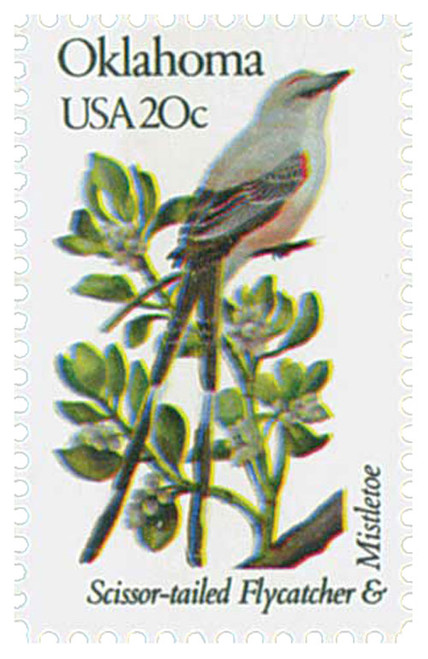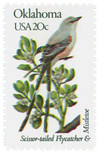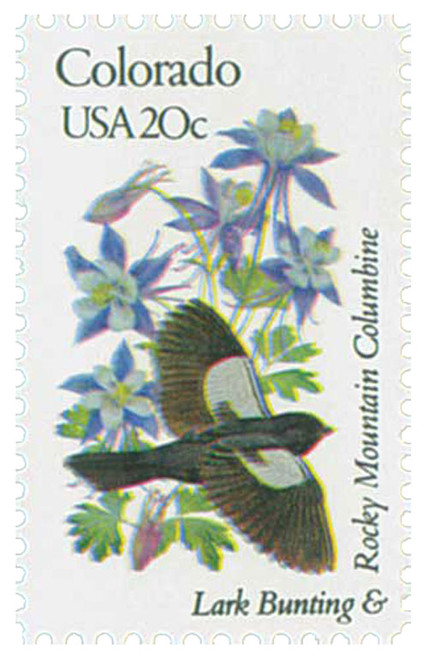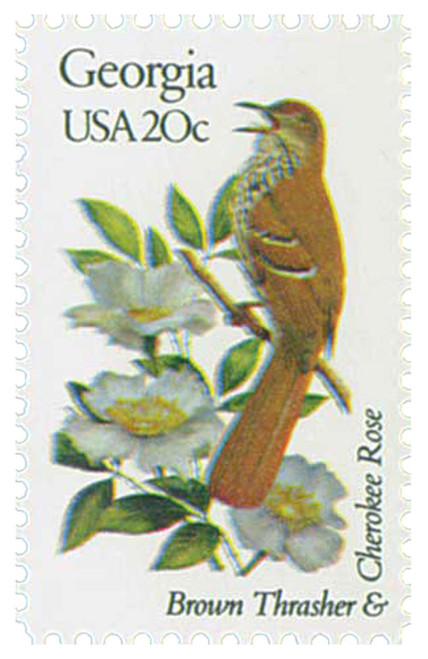
# 1988 - 1982 20c State Birds and Flowers: Oklahoma
20¢ Oklahoma
State Birds and Flowers
City: Washington, DC and state capitals
Quantity: 13,339,000 panes
Printed By: Bureau of Engraving and Printing
Printing Method: Photogravure
Perforations: 10.5 x 11.25
Color: Multicolored
Oklahoma Becomes 46th State
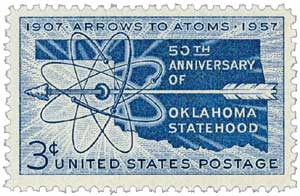
On November 16, 1907, Indian Territory and Oklahoma Territory were merged to create the state of Oklahoma.
Arapaho, Caddo, Cheyenne, Comanche, Kiowa, Osage, Pawnee, and Wichita Indians lived in the Oklahoma region before Europeans came to the area. These people followed the gigantic herds of buffalo that roamed the grasslands.
Spanish explorers were the first whites to reach Oklahoma. In 1541, Francisco Vásquez de Coronado commanded an expedition that traveled from Tiguex, New Mexico, to present-day Oklahoma. Another Spaniard, Hernando de Soto, may have reached the area. Both expeditions were searching for gold. Neither was successful.
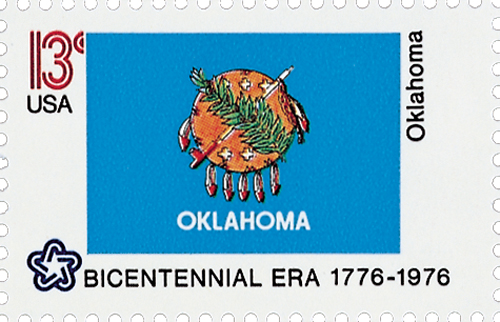
In 1682, René-Robert Cavelier, a French explorer, traveled down the Mississippi River. Although he did not enter Oklahoma, he claimed all the land drained by the Mississippi for France. This territory was called Louisiana, and included Oklahoma. This led to many explorers, fur traders, and trappers coming to Oklahoma.
France claimed Louisiana until 1762, when it was sold to Spain. Napoleon regained Louisiana in 1800, and then sold this massive parcel of land to the United States in 1803. Oklahoma then became part of the U.S.
The Louisiana Territory consisted of 827,987 square miles of land. Congress divided the territory for administrative purposes. The territory was reorganized several times. At first, Louisiana was part of the District of Louisiana. In 1805, it became part of the Louisiana Territory. In 1812, the Missouri Territory was organized from the Louisiana Territory. Then, in 1819, the U.S. settled a boundary dispute with Spain. As part of the settlement, the Oklahoma panhandle was given to Spain. That same year, sections of Oklahoma became part of the Arkansas Territory.
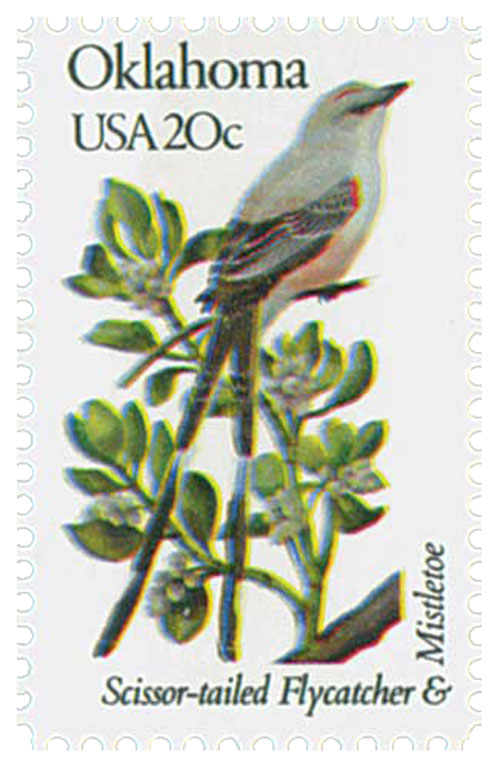
For more than a hundred years, the Cherokee, Chickasaw, Choctaw, Creek, and Seminole Indians had lived in close proximity to Europeans in the southeastern U.S. These people had adopted a great deal of European culture and were known as the Five Civilized Tribes. In 1819, the U.S. government began pressuring the Five Civilized Tribes to move west to Oklahoma. At that time, Oklahoma was mostly unpopulated. The government built Fort Towson and Fort Gibson, and forced the Five Tribes to move there. From 1830-1842, the Indians made the trip to eastern Oklahoma. Thousands of them died along the way. The journey came to be known as the “Trail of Tears.”
The Five Civilized Tribes were given control of all of Oklahoma except the Panhandle. Treaties stated the Indians would own the lands “as long as grass shall grow and rivers run.” Each tribe developed its own legislature, courts, laws, and capital. Farms and ranches were established, and churches and schools were built. Treaties protected the tribes from white settlement – until the Civil War.
The Five Civilized Tribes owned slaves. Originally from the South, they were invited to join the Confederacy. In 1861, some of the Indians entered into a treaty of alliance with the Confederacy. The leader of the Cherokee Indians, Chief John Ross, formed a brigade of Indians to fight for the South. Stand Watie, a Cherokee leader, became a brigadier general in the Confederate Army. A small number of Indians chose to fight for the Union. After the Civil War, the U.S. government forced the Indians to relinquish their lands in the West as a punishment for supporting the Confederacy.

The land bordering the Indian Territory was quickly filled with white settlers. White cattle ranchers began driving their herds across these fertile lands as they traveled from Texas to rail centers in Kansas. Over 6 million longhorn cattle crossed the Indian land between 1866 and 1885. Cattlemen leased more than 6 million acres of Indian land for five years, but these leases were declared illegal.
After a great deal of pressure from “boomers” (whites who wanted Indian land opened for settlement), the government changed its policy. The U.S. bought three million acres of land from the Creek and Seminole tribes. At noon on April 22, 1899, 1.9 million acres were opened for settlement. Settlers amassed at the border, ready to seize prime land. With a pistol shot, settlers raced into the land. By evening, 50,000 white families had moved to Oklahoma. In the course of a single day, Guthrie and Oklahoma City had become cities with populations over 10,000.
Congress established the Oklahoma Territory in May 1890. Guthrie served as the capital, and the panhandle was added to the territory. (The panhandle had become U.S. territory when Texas joined the Union.)

Over time, the Indians accepted individual allotment of their lands. This meant individuals held land titles, rather than tribes. Land not allotted to Indians was opened for settlement by whites. The biggest land opening took place on September 16, 1893. On that date, the Cherokee Outlet and the Tonkawa and Pawnee reservations were opened for settlement. On the very first day, 50,000 people claimed 6.5 million acres of land.
By 1890, Oklahoma was often referred to as the Twin Territories. The Indian Territory consisted of the land owned by the Five Civilized Tribes, as well as some other Indian groups. The Oklahoma Territory made up the remaining land. White settlers began demanding access to the Indian land. In 1893, the Dawes Commission was created to negotiate with the Indians and dissolve their nations. The commission helped the Indians incorporate towns and prepare for U.S. citizenship.

In 1905, Indian leaders called a constitutional convention and invited white citizens to participate. (Whites outnumbered the Indians five to one.) A constitution was adopted, but Congress refused to accept the state, instead asking for the two territories to form one larger state. Delegates from both territories met in 1906, and created a new constitution. On November 16, 1907, Oklahoma achieved statehood. Guthrie served as the first capital; Oklahoma City became the capital in 1910.
Oil and natural gas have added a great deal to the state’s economy. Agriculture also contributes greatly to the state’s economic well being. More than half the agricultural revenue is produced from livestock. Tourism is an important, growing source of income as well.
20¢ Oklahoma
State Birds and Flowers
City: Washington, DC and state capitals
Quantity: 13,339,000 panes
Printed By: Bureau of Engraving and Printing
Printing Method: Photogravure
Perforations: 10.5 x 11.25
Color: Multicolored
Oklahoma Becomes 46th State

On November 16, 1907, Indian Territory and Oklahoma Territory were merged to create the state of Oklahoma.
Arapaho, Caddo, Cheyenne, Comanche, Kiowa, Osage, Pawnee, and Wichita Indians lived in the Oklahoma region before Europeans came to the area. These people followed the gigantic herds of buffalo that roamed the grasslands.
Spanish explorers were the first whites to reach Oklahoma. In 1541, Francisco Vásquez de Coronado commanded an expedition that traveled from Tiguex, New Mexico, to present-day Oklahoma. Another Spaniard, Hernando de Soto, may have reached the area. Both expeditions were searching for gold. Neither was successful.

In 1682, René-Robert Cavelier, a French explorer, traveled down the Mississippi River. Although he did not enter Oklahoma, he claimed all the land drained by the Mississippi for France. This territory was called Louisiana, and included Oklahoma. This led to many explorers, fur traders, and trappers coming to Oklahoma.
France claimed Louisiana until 1762, when it was sold to Spain. Napoleon regained Louisiana in 1800, and then sold this massive parcel of land to the United States in 1803. Oklahoma then became part of the U.S.
The Louisiana Territory consisted of 827,987 square miles of land. Congress divided the territory for administrative purposes. The territory was reorganized several times. At first, Louisiana was part of the District of Louisiana. In 1805, it became part of the Louisiana Territory. In 1812, the Missouri Territory was organized from the Louisiana Territory. Then, in 1819, the U.S. settled a boundary dispute with Spain. As part of the settlement, the Oklahoma panhandle was given to Spain. That same year, sections of Oklahoma became part of the Arkansas Territory.

For more than a hundred years, the Cherokee, Chickasaw, Choctaw, Creek, and Seminole Indians had lived in close proximity to Europeans in the southeastern U.S. These people had adopted a great deal of European culture and were known as the Five Civilized Tribes. In 1819, the U.S. government began pressuring the Five Civilized Tribes to move west to Oklahoma. At that time, Oklahoma was mostly unpopulated. The government built Fort Towson and Fort Gibson, and forced the Five Tribes to move there. From 1830-1842, the Indians made the trip to eastern Oklahoma. Thousands of them died along the way. The journey came to be known as the “Trail of Tears.”
The Five Civilized Tribes were given control of all of Oklahoma except the Panhandle. Treaties stated the Indians would own the lands “as long as grass shall grow and rivers run.” Each tribe developed its own legislature, courts, laws, and capital. Farms and ranches were established, and churches and schools were built. Treaties protected the tribes from white settlement – until the Civil War.
The Five Civilized Tribes owned slaves. Originally from the South, they were invited to join the Confederacy. In 1861, some of the Indians entered into a treaty of alliance with the Confederacy. The leader of the Cherokee Indians, Chief John Ross, formed a brigade of Indians to fight for the South. Stand Watie, a Cherokee leader, became a brigadier general in the Confederate Army. A small number of Indians chose to fight for the Union. After the Civil War, the U.S. government forced the Indians to relinquish their lands in the West as a punishment for supporting the Confederacy.

The land bordering the Indian Territory was quickly filled with white settlers. White cattle ranchers began driving their herds across these fertile lands as they traveled from Texas to rail centers in Kansas. Over 6 million longhorn cattle crossed the Indian land between 1866 and 1885. Cattlemen leased more than 6 million acres of Indian land for five years, but these leases were declared illegal.
After a great deal of pressure from “boomers” (whites who wanted Indian land opened for settlement), the government changed its policy. The U.S. bought three million acres of land from the Creek and Seminole tribes. At noon on April 22, 1899, 1.9 million acres were opened for settlement. Settlers amassed at the border, ready to seize prime land. With a pistol shot, settlers raced into the land. By evening, 50,000 white families had moved to Oklahoma. In the course of a single day, Guthrie and Oklahoma City had become cities with populations over 10,000.
Congress established the Oklahoma Territory in May 1890. Guthrie served as the capital, and the panhandle was added to the territory. (The panhandle had become U.S. territory when Texas joined the Union.)

Over time, the Indians accepted individual allotment of their lands. This meant individuals held land titles, rather than tribes. Land not allotted to Indians was opened for settlement by whites. The biggest land opening took place on September 16, 1893. On that date, the Cherokee Outlet and the Tonkawa and Pawnee reservations were opened for settlement. On the very first day, 50,000 people claimed 6.5 million acres of land.
By 1890, Oklahoma was often referred to as the Twin Territories. The Indian Territory consisted of the land owned by the Five Civilized Tribes, as well as some other Indian groups. The Oklahoma Territory made up the remaining land. White settlers began demanding access to the Indian land. In 1893, the Dawes Commission was created to negotiate with the Indians and dissolve their nations. The commission helped the Indians incorporate towns and prepare for U.S. citizenship.

In 1905, Indian leaders called a constitutional convention and invited white citizens to participate. (Whites outnumbered the Indians five to one.) A constitution was adopted, but Congress refused to accept the state, instead asking for the two territories to form one larger state. Delegates from both territories met in 1906, and created a new constitution. On November 16, 1907, Oklahoma achieved statehood. Guthrie served as the first capital; Oklahoma City became the capital in 1910.
Oil and natural gas have added a great deal to the state’s economy. Agriculture also contributes greatly to the state’s economic well being. More than half the agricultural revenue is produced from livestock. Tourism is an important, growing source of income as well.

